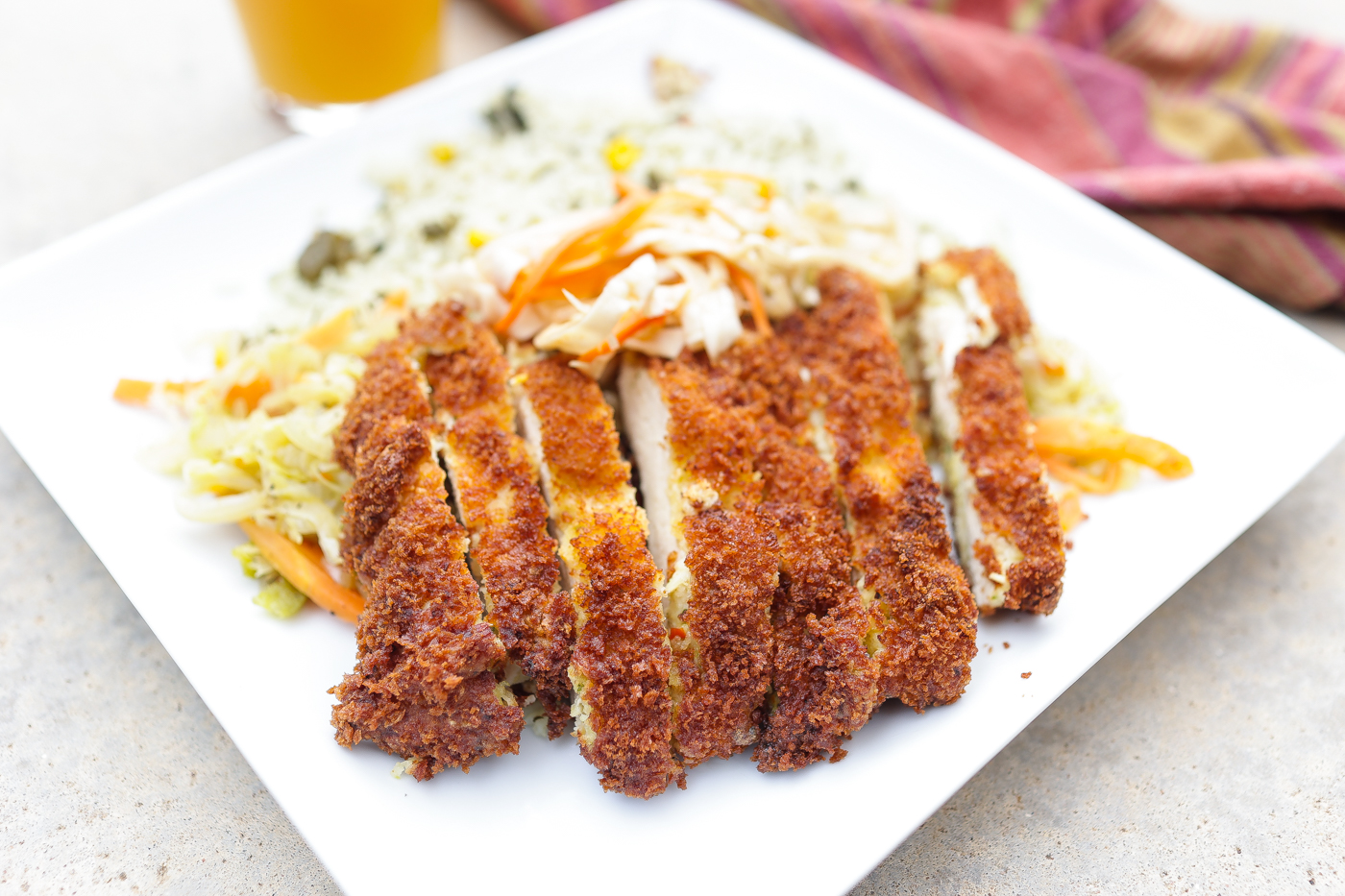I love chicken katsu, but often feel like it could use a flavor boost! This fusion chicken katsu recipe elevates things big time! It's a crispy shendig marrying Japanese traditional technique with Caribbean flavor.
Related Fried Chicken Posts:
Step into a culinary groove where Japan meets the Caribbean, baby! Picture this: succulent chicken katsu, strutting its crispy rhythm, dipped in the flavorful vibes of Haitian Epis seasoning and a sprinkle of Caribbean spice magic.
It's a melody of flavors, a symphony of soulful bites so, grab a seat, and let's set the stage for a dining experience that's smooth, savory, and oh-so-soulful! Get ready to groove with each mouthwatering note in this fusion feast – a harmony of Japan and the Caribbean coming together to cold rock this flavor party like nobody's business!
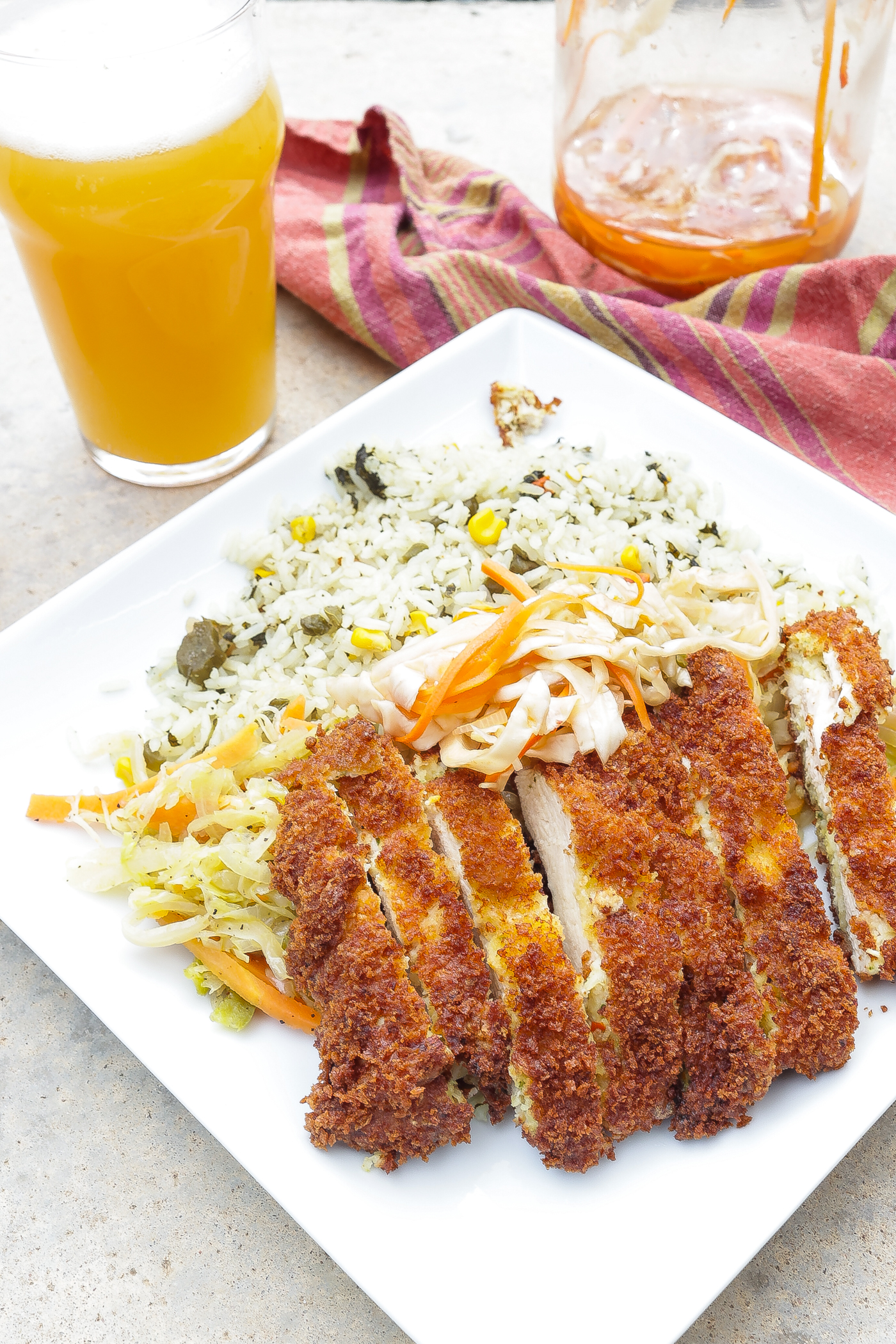
What Is Katsu?
Katsu" typically refers to a Japanese dish called "katsu," short for "katsuretsu." It's basically Japanese fried chicken. It commonly involves a breaded and deep-fried cutlet of meat, often pork cutlets or chicken. If you've ever had schnitzel or Milanese, katsu is very similar.
The dish is often served with rice, shredded cabbage, and a savory sauce, such as tonkatsu sauce. There are variations of katsu, including tonkatsu (pork cutlet) and chicken katsu. It's a popular and delicious dish in Japanese cuisine.
I'm partial to the chicken version. I love that it is both super light and crispy while also remaining tender and juicy. My only gripe is most versions I've tried have been light on the seasoning. That's where the Caribbean vibes come in.
What Is Haitian Epis?
Haitian épis, also known as épis seasoning, is a traditional Haitian seasoning base (similar to a sofrito or green seasoning) used in Haitian cuisine. It is a mixture of various herbs, spices, and aromatics that are finely blended together.
The exact ingredients can vary, but typical épis seasoning includes elements like garlic, thyme, parsley, bell peppers, scallions, onions, and various spices. It's often used as a base for flavoring a variety of Haitian dishes, adding depth and complexity to the flavors.
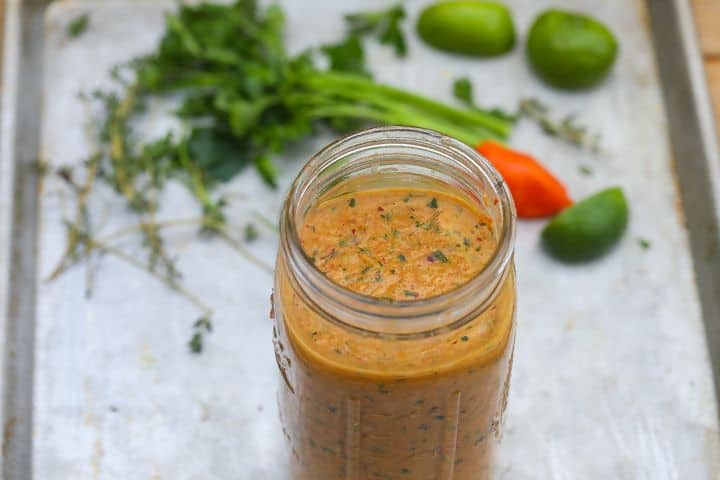
Beats and Eats
The pairing of Sonya Spence's song "Let Love Flow On" with chicken katsu seasoned with Haitian épis is a beautiful thing for many reasons:
- Soulful Vibes: Sonya Spence's soulful voice and the smooth rhythm of "Let Love Flow On" bring a warm and comforting atmosphere. This complements the comforting and satisfying taste of chicken katsu.
- Balanced Harmony: The song's balanced melody and the balanced blend of spices in Haitian épis work together to create a sense of harmony. Similarly, the crispy exterior of the chicken katsu balances with the aromatic and flavorful seasoning.
- Mood Enhancement: Both music and food have the power to evoke emotions. The uplifting and positive message of "Let Love Flow On" will enhance the overall mood of the dining experience, making it more enjoyable.
- Cultural Appreciation: Pairing music from one culture with food from another is a celebration of diversity and cultural appreciation. It allows for a cross-cultural experience that transcends geographical boundaries.
Ingredients Needed To Make Homemade Chicken Katsu
- Boneless Skinless Chicken Breast - though I think skinless chicken thighs are more flavorful than chicken breasts I prefer the latter for the faster cook time.
- Eggs - Beating eggs and dipping the chicken cutlets in the egg mixture before coating them in breadcrumbs helps create a sticky surface. This helps the breadcrumbs adhere to the chicken, forming a crispy and golden crust during the frying process. Eggs also contribute moisture to the chicken, preventing it from drying out during the frying process.
- All-purpose Flour - The flour helps create a dry surface on the chicken (which you'll need to counter the moisture in the epis), allowing the subsequent egg wash to adhere better. Flour helps create an even and consistent coating on the chicken cutlet. This ensures that the breadcrumbs adhere uniformly, providing a balanced texture throughout the dish.
- Panko Bread Crumbs - Panko breadcrumbs are coarser and larger than traditional breadcrumbs, providing a superior level of crispiness. When fried, panko creates a light and airy texture that adds a delightful crunch to the chicken katsu, enhancing the overall eating experience. The distinct appearance of panko crumbs gives the chicken katsu a visually appealing golden-brown color and a textured surface
Ingredients for Flavor Boost
- Smoked Paprika -imparts a smoky flavor to the chicken katsu. This adds a unique and savory dimension to the dish, providing a hint of smokiness that complements the crispy and savory nature of the fried chicken.
- Allspice - Allspice is named for its ability to mimic the combined flavors of cinnamon, nutmeg, and cloves. Adding allspice to chicken katsu introduces a complex and multi-layered taste that goes beyond a single spice, creating a more interesting and nuanced flavor profile.
- Kosher Salt
- Black Pepper
- Haitian Epis Seasoning - adds a unique and flavorful Caribbean twist to chicken katsu. Many ingredients in Haitian epis, including green herbs and colorful peppers, can enhance the visual appeal of the chicken katsu. The vibrant colors contribute to an appetizing presentation.
How To Make Chicken Katsu With Haiting Epis
Make The Epis:
Place all epis ingredients in a blender or food processor and puree to desired consistency. I prefer a salsa-like consistency. Set aside.
Prepare Chicken Rub (seasoning)
Place all dry spices in a small bowl or ramekin, mix well, and set aside.
Prepare the Chicken:
Lay out the chicken breasts. Place them in plastic ziplock bags and pound them flat using the bottom of a cast iron skillet or a meat mallet.
Season the chicken on both sides with a third of the seasoning mix. Add the epis and marinate overnight.
Dredge in Flour:
Add the flour to a large bowl. Mix in half of the remaining spice mix and stir well. Dredge each chicken breast in all-purpose flour mix, ensuring even coating. Shake off any excess flour.
Coat with Beaten Eggs:
In a shallow bowl, add the eggs and beat them. Dip each chicken breast into the beaten eggs, coating both sides thoroughly.
Cover with Panko Bread Crumbs:
Place panko bread crumbs in a separate shallow dish. Add the last of the spice mix and mix well. Press each chicken breast into the panko crumbs, ensuring a full and even coating. Press the crumbs onto the chicken to help them adhere.
Set Aside and Heat Oil:
Place the breaded chicken on a plate or wire rack lined baking sheet and set it aside. Meanwhile, heat vegetable oil in a large frying pan over medium-high heat. The oil should be hot enough for frying (around 350-375°F or 175-190°C).
Fry the Chicken:
Carefully place the breaded chicken breasts into the hot oil. Fry each side until golden brown and crispy, usually around 3-4 minutes per side depending on thickness. Ensure the internal temperature of the chicken reaches 165°F (74°C).
Drain Excess Oil:
Once fried, transfer the chicken katsu to a plate lined with paper towels to drain any excess oil.
Slice and Serve:
Let the chicken rest for a few minutes before slicing it into thin slices, strips or pieces. Serve hot.
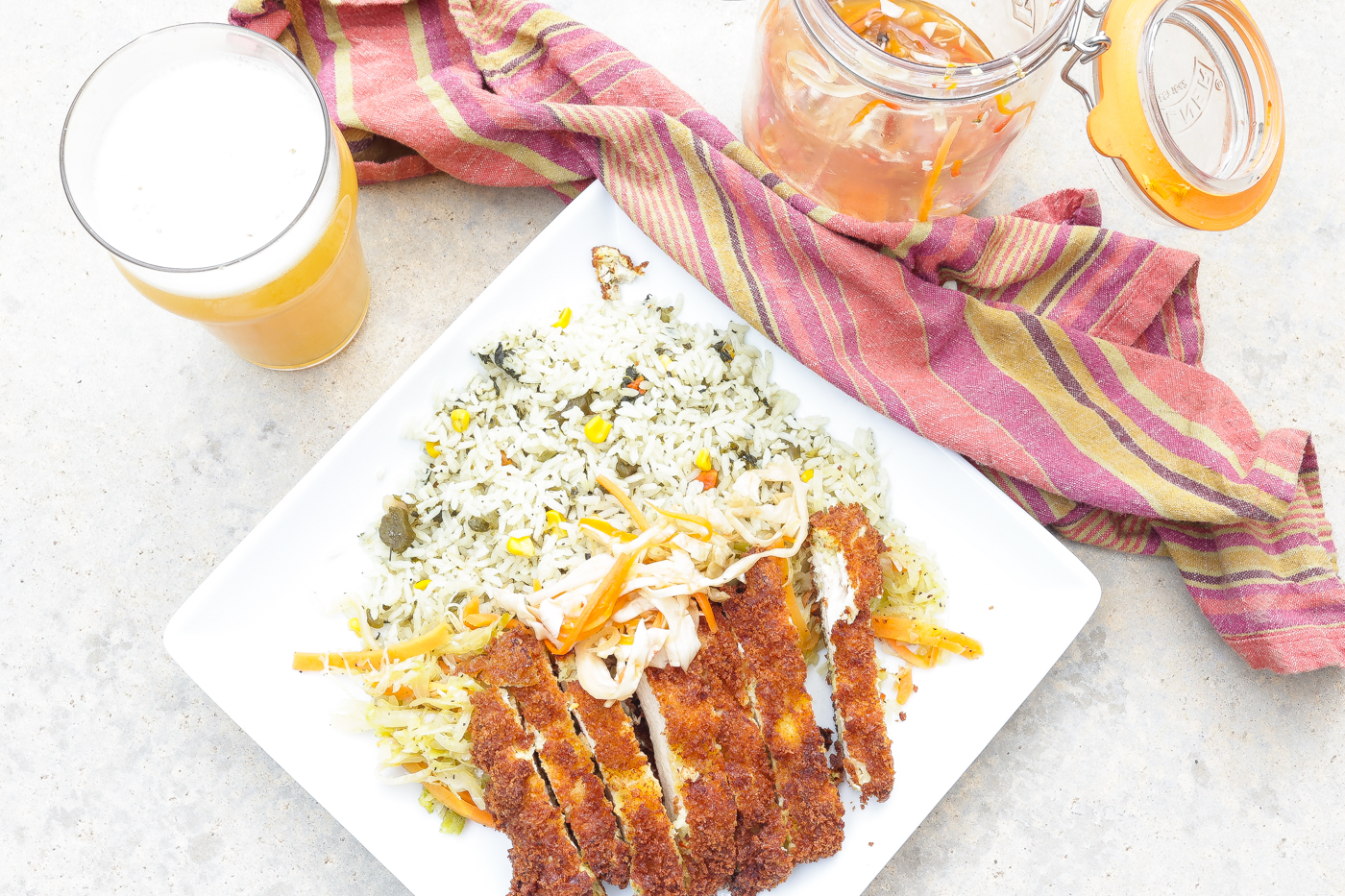
What To Serve With Katsu
Chicken katsu pairs well with a variety of side dishes and accompaniments. Here are some popular options to serve with katsu:
- Steamed Rice: A classic choice, steamed white rice complements the crispy and flavorful nature of chicken katsu.
- Cabbage Salad or Slaw: Shredded cabbage served with a light dressing, often made with vinegar, mayonnaise, and a touch of sugar, adds a refreshing crunch to the meal.
- Pickled Vegetables: Japanese pickles, such as daikon radish or cucumber pickles, add a tangy and refreshing component to the meal.
- Japanese Curry: Serve chicken katsu with Japanese curry and rice for a comforting and hearty dish.
- Soba or Udon Noodles: Enjoy chicken katsu with a side of soba or udon noodles, either hot or cold, for a satisfying and complete meal.
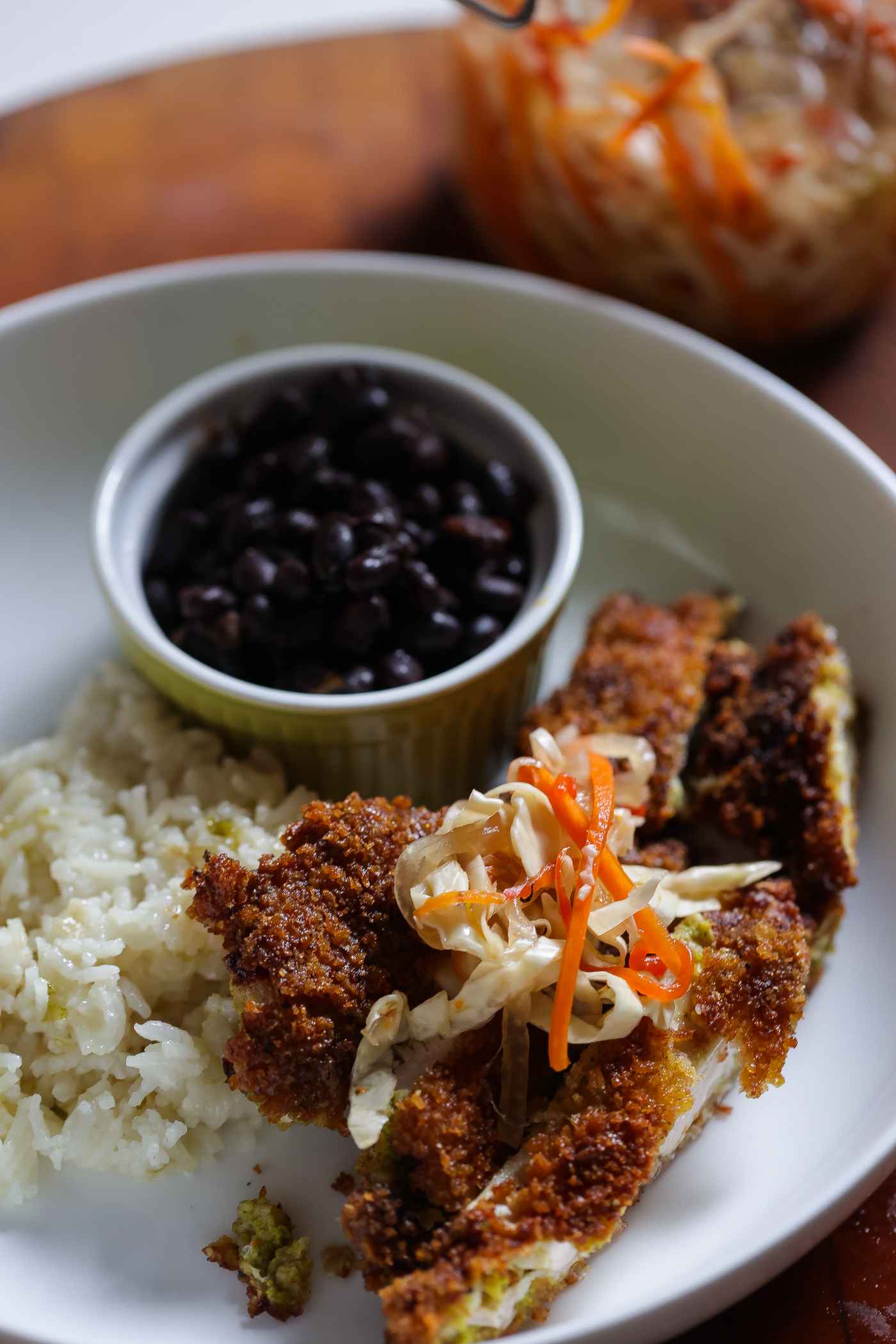
Optimizing For Flavor
To maximize flavor in chicken katsu, consider the following tips:
- Season the Flour and Bread Crumbs: Add additional flavor to the breading process by seasoning the all-purpose flour. This ensures that each layer contributes to the overall taste of the dish.
- Garnish with Fresh Herbs: Sprinkle freshly chopped herbs like cilantro, parsley, or green onions over the finished chicken katsu. The brightness of the herbs adds a burst of freshness to each bite.
- Squeeze of Citrus: A squeeze of fresh lemon or lime juice just before serving can add a zesty and citrusy element, cutting through the richness of the fried chicken.
- Experiment with Spices: Customize the seasoning blend to your liking by experimenting with different spices like smoked paprika, cumin, or a dash of curry powder. Adjust the spice level according to your preferences.
- Quality Ingredients: Use high-quality and fresh ingredients to ensure that the natural flavors of the chicken shine through. Fresh chicken and quality seasonings make a significant difference in the final taste.
Katsu Sauce Ideas
Katsu sauce, also known as tonkatsu sauce, is a sweet and savory condiment that is commonly served with Japanese dishes like chicken katsu and pork tonkatsu. The sauce typically consists of a combination of the following ingredients:
- Worcestershire Sauce: A key component that provides a savory and umami-rich base to the sauce.
- Ketchup: Adds sweetness and a tomatoey flavor to balance the savory elements.
- Soy Sauce: Contributes saltiness and depth of flavor.
- Sugar: Adds sweetness to counterbalance the savory and salty components.
- Mirin or Rice Vinegar: Provides a touch of sweetness and acidity.
- Garlic Powder or Fresh Garlic (optional): For additional flavor, some recipes include garlic.
- Ginger (optional): Some variations may include grated or minced ginger for a hint of warmth.
I skipped the typical sauce and stayed with my Haitian theme by topping my finished cutlets with pikliz which is a popular condiment in Haiti. Pikliz is basically a briny and spicy pickled cabbage dish. If you don't want to make your own sauce or condiment, I do like that Bachan's Japanese Barbecue Sauce.
Make This Chicken Katsu Recipe
Combining the Japanese tradition of chicken katsu with the flavorful Haitian epis seasoning results in a culinary fusion that excites the palate with diverse and harmonious tastes. The crispy and golden-brown exterior of the chicken katsu, achieved through a meticulous breading process with panko crumbs, perfectly complements the rich and aromatic undertones of Haitian epis.
The blend of herbs, spices, and cultural influences creates a unique dining experience where the savory and crunchy elements of the Japanese dish harmonize with the complex and aromatic notes of Haitian cuisine. This fusion not only showcases the versatility of global flavors but also offers a delightful and satisfying meal that celebrates the best of both culinary worlds.
If you make this great recipe or any other from the site, please come back and leave me a comment below with your feedback. Definitely take a photo of the dish and be sure to tag #foodfidelity so that I can see them.
You can also keep up with my food exploits as well as original recipes! You can find me on Instagram, Facebook, Twitter, and Pinterest. If you like any of the music you find on the site, visit me at Spotify to find curated monthly playlists.
Lastly, go to my YouTube channel and subscribe to be notified when new weekly videos are uploaded.
Ingredients
- 4 boneless skinless chicken breasts
- 2 teaspoons smoked paprika
- 1 ½ teaspoon allspice
- 1 teaspoon kosher salt
- 1 teaspoon black pepper
- 1 cup all-purpose flour
- 2 large eggs
- 2 cups panko bread crumbs
- Vegetable oil for frying
- 2 cups Haitian Epis Seasoning
Instructions
Make The Epis:
- Place all epis ingredients in a blender or food processor and puree to desired consistency. I prefer a salsa-like consistency. Set aside.
Prepare Chicken Rub (seasoning)
- Place all dry spices in a small bowl or ramekin, mix well, and set aside.
Prepare the Chicken:
- Lay out the chicken breasts. Place them in plastic ziplock bags and pound them flat using the bottom of a cast iron skillet or a meat mallet.
- Season the chicken on both sides with a third of the seasoning mix. Add the epis and marinate overnight.
Dredge in Flour:
- Add the flour to a large bowl. Mix in half of the remaining spice mix and stir well. Dredge each chicken breast in all-purpose flour mix, ensuring even coating. Shake off any excess flour.
Coat with Beaten Eggs:
- In a shallow bowl, add the eggs and beat them. Dip each chicken breast into the beaten eggs, coating both sides thoroughly.
Cover with Panko Bread Crumbs:
- Place panko bread crumbs in a separate shallow dish. Add the last of the spice mix and mix well. Press each chicken breast into the panko crumbs, ensuring a full and even coating. Press the crumbs onto the chicken to help them adhere.
Set Aside and Heat Oil:
- Place the breaded chicken on a plate or wire rack lined baking sheet and set it aside. Meanwhile, heat vegetable oil in a large frying pan over medium-high heat. The oil should be hot enough for frying (around 350-375°F or 175-190°C).
Fry the Chicken:
- Carefully place the breaded chicken breasts into the hot oil. Fry each side until golden brown and crispy, usually around 3-4 minutes per side depending on thickness. Ensure the internal temperature of the chicken reaches 165°F (74°C).
Drain Excess Oil:
- Once fried, transfer the chicken katsu to a plate lined with paper towels to drain any excess oil.
Slice and Serve:
- Let the chicken rest for a few minutes before slicing it into thin slices, strips or pieces. Serve hot.
Video

Notes
- Season the Flour and Bread Crumbs: Add additional flavor to the breading process by seasoning the all-purpose flour. This ensures that each layer contributes to the overall taste of the dish.
- Garnish with Fresh Herbs: Sprinkle freshly chopped herbs like cilantro, parsley, or green onions over the finished chicken katsu. The brightness of the herbs adds a burst of freshness to each bite.
- Squeeze of Citrus: A squeeze of fresh lemon or lime juice just before serving can add a zesty and citrusy element, cutting through the richness of the fried chicken.
- Experiment with Spices: Customize the seasoning blend to your liking by experimenting with different spices like smoked paprika, cumin, or a dash of curry powder. Adjust the spice level according to your preferences.
- Quality Ingredients: Use high-quality and fresh ingredients to ensure that the natural flavors of the chicken shine through. Fresh chicken and quality seasonings make a significant difference in the final taste.

